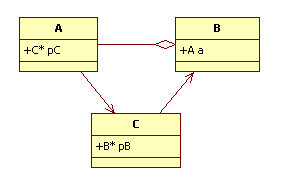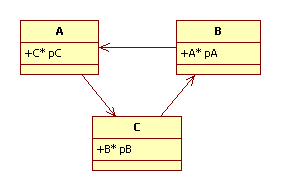[S/E] Term confusion - Association and Object Association
Information/Programming :
2008. 3. 23. 23:55
This post is dedicated to 바람, who is currently confused with the terms that I used on March 17th's post(How is Aggregation and Composition different?) and which Wikipedia uses.
I am assuming that all the confusion started from the word object association which is a term used in Object-Oriented programming paradigm. According to Wikipedia, object association is described as a concept of building objects from other objects [1]. My understanding is that this word has nothing to do with the term association which describes the relationship between objects. The term association is used to define the relationship among objects when their scope does not overlap from one another. The concept of object association is also used to define the relationship among objects, but only when their scope is nested inside one another.
Recall that association is also called a "knows-a relationship" while aggregation and composition is called a "has-a relationship". I personally think that these simplified terms are descriptive enough for everyone to understand this topic better.
If I would elaborate more on association, association provides a mechanism to an object to interact between other objects within its own scope. If my explanation isn't clear for you and wish for more information, refer to [2]. For aggreation and composition, refer to [3].
Basically, my point here is that not to be confused with association among objects and the concept of object association.
References
[1] http://en.wikipedia.org/wiki/Object_association
[2] http://en.wikipedia.org/wiki/Association_%28object-oriented_programming%29
[3] http://en.wikipedia.org/wiki/Object_composition#Aggregation
I am assuming that all the confusion started from the word object association which is a term used in Object-Oriented programming paradigm. According to Wikipedia, object association is described as a concept of building objects from other objects [1]. My understanding is that this word has nothing to do with the term association which describes the relationship between objects. The term association is used to define the relationship among objects when their scope does not overlap from one another. The concept of object association is also used to define the relationship among objects, but only when their scope is nested inside one another.
Recall that association is also called a "knows-a relationship" while aggregation and composition is called a "has-a relationship". I personally think that these simplified terms are descriptive enough for everyone to understand this topic better.
If I would elaborate more on association, association provides a mechanism to an object to interact between other objects within its own scope. If my explanation isn't clear for you and wish for more information, refer to [2]. For aggreation and composition, refer to [3].
Basically, my point here is that not to be confused with association among objects and the concept of object association.
References
[1] http://en.wikipedia.org/wiki/Object_association
[2] http://en.wikipedia.org/wiki/Association_%28object-oriented_programming%29
[3] http://en.wikipedia.org/wiki/Object_composition#Aggregation
'Information > Programming' 카테고리의 다른 글
| Building curl 17.19.3 with OpenSSL and zlib on MSVC (2) | 2009.02.03 |
|---|---|
| Building openSSL 0.9.8j on Windows (2) | 2009.02.02 |
| Working with WebCore in Webkit... (4) | 2009.01.13 |
| Making your code more portable by avoiding inlining??? (6) | 2008.11.23 |
| GNU Libtool 사용해서 shared object library 만들어보기 (5) | 2008.10.25 |
| [VC++] Need a more accurate timer? (0) | 2008.03.18 |
| [S/E] How is Aggregation and Composition different? (11) | 2008.03.17 |
| [Algorithm] 변수 없이 Swap하기, but not an option? (11) | 2008.02.26 |
| [VC++] Window의 초기 크기와 위치 정해주기 (1) | 2008.02.24 |
| [C++] in/out parameter passing by reference? And your preference? (0) | 2008.02.21 |










